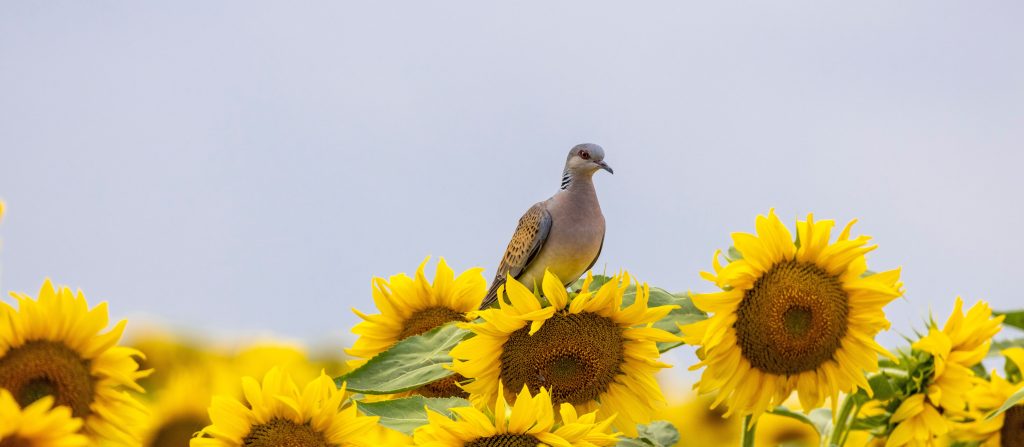A brighter future for the European Turtle‑dove?

Discussions about the European Turtle-dove are often centred around phrases like 'worrying decline,' 'depleted populations,' and comparisons to the fate of the Passenger Pigeon, which went extinct at the beginning of the 20th century. But now, there are signs of recovery of the western breeding population!
The European Turtle-dove (Streptopelia turtur) is a species that has experienced one of the most significant declines in Europe, and currently has the conservation status of Vulnerable. It nests in patchy habitats with open agricultural land, often adjacent to wooded areas with trees, hedgerows and bushes. The main drivers of its decline are habitat loss and degradation due to intensive agriculture and taking through hunting and illegal killing.
Let’s dive deeper into the first signs of the comeback of this magnificent bird with its gentle purr.
A European Turtle-dove action plan
Commissioned by the European Commission, our partner in the UK, the Royal Society for the Protection of Birds (RSPB), developed a Species Action Plan as part of the LIFE EuroSAP project of BirdLife Europe. This plan, published in 2018, outlines the necessary recovery actions with input from various stakeholders and scientists. It represents one of the first significant milestones in the recovery of the European Turtle-dove.
Another important step was the European Commission’s investment in the collection and analysis of Turtle-dove data to feed into the Adaptive Harvest Management (AHM) Model. This model helps make informed decisions about the sustainable harvesting of a species, balancing conservation with the needs of hunters and other stakeholders. The results for the Turtle-dove determined that an immediate zero-take policy was necessary.
A zero-take policy
With the results of the AHM Model, the European Commission recommended a zero-take hunting season for the European Turtle-dove in the autumn of 2021. This was applied to the western flyway, covering France, Spain, Portugal and the north-western part of Italy. Initially, a 50% reduction of take was suggested for the central-eastern flyway, which includes Austria, Bulgaria, Greece, Italy, Malta, Romania and Cyprus. In 2022 and 2023, a zero-take policy was recommended for both flyways.
And it seems like these steps are paying off! According to the Pan-European Common Bird Monitoring Scheme (PECBMS), the Turtle-dove breeding population, which experienced a continuous decline from 2007 to 2021, has begun to rebound, achieving its highest population size in 2023 since 2011 along the western flyway. The 10-year population trend has improved from “moderate decline” to “stable,” underscoring the significant positive impact of the hunting ban.
Instead, Member States on the central-eastern flyway either ignored the recommendation from the Commission, or only implemented it partly. Sadly, the Turtle-dove breeding population on the central-eastern flyway continues to decline, with the population having nearly halved over the past 20 years. The 10-year trend in this region has worsened from “stable” to “moderate decline”. As of now, it is still to be seen if the full implementation of the zero-take policy and the eradication of illegal hunting will allow the central-eastern population to recover. Encouragingly, as of 2024, all Austrian regions announced that they will impose a zero-take policy on Turtle-doves.

And while the data for the western flyway is promising, efforts to properly enforce the hunting ban in all countries must continue until the species is fully recovered.
Making a change together
The efforts made by EU countries to restrict hunting are setting inspirational examples for other countries along the species’ flyway, beyond the EU. Countries like Israel and Serbia have already taken steps to stop unsustainable hunting practices.
BirdLife is grateful that the European Commission is committed to restoring threatened species and has successfully engaged Member States and stakeholders. Together with our BirdLife Partners, we remain dedicated to achieving the full recovery of the species.

Cover picture by Cristian Zamfir/Shutterstock
Written by Willem Van Den Bossche
You might also interested in:
 | Stichting BirdLife Europe gratefully acknowledges financial support from the European Commission. All content and opinions expressed on these pages are solely those of Stichting BirdLife Europe. The European Commission is not responsible for any use that may be made of the information it contains. |









